Las estatuas vivientes no solo besan a Cuba [ESP-ENG]
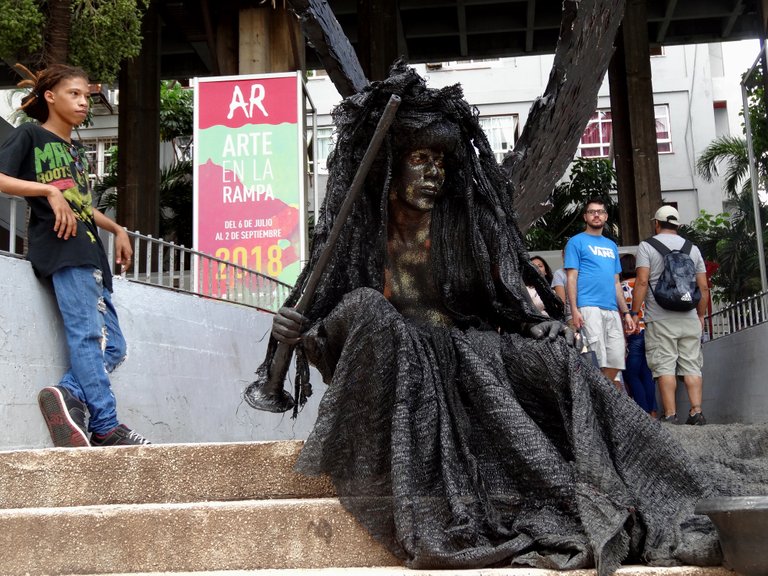
Una chica bien atractiva, se acerca a su cara inmóvil. Cuando todos pensaron que tocaría su rostro, se le abalanzó a sus labios para robarle un beso. La estatua masculina no pudo resistirse a los encantos de esa mujer, y cobró vida ante los presentes.
Si un lugar en la Habana concentra y desarrolla la parte sociocultural del país es el reparto Vedado. Donde se aglutinan muchas personas que vienen para sentir y conocer en carne propia, los sabores y la dinámica de nuestras tradiciones y el arte público.
Corría el mes de julio del 2018, y estaba de paseo por esa zona con mi esposa e hijos. Tras endulzar y enfriar los paladares con varias ensaladas de helado, fuimos al centro expositivo Pabellón Cuba, donde se desarrollaba en ese momento la Feria de la Cultura Cubana Arte en la Rampa.
Al llegar, nos da la bienvenida un personaje femenino, vestida de negro, con manchas bronceadas y oscuras en su cara, falda y cabello largo ondulado con mechas, al estilo medusa. Portaba en su brazo derecho un clarinete como instrumento de viento.
Para muchos chicos, pueden verla como un ser estático que les hace volar su imaginación; para los que ya conocen, saben que se trata de las llamadas estatuas vivientes. Esos artistas de la calle que posan como una escultura inanimada, simulando a personajes históricos o ficticios.
Parecen inmóviles, pintados de color plateado, dorado, y con gradaciones que van desde el blanco al negro. Les encanta pasar desapercibidos, pero la curiosidad humana, y más la de los niños, logran su efecto contrario, al ser focos de la atracción pública y de inspirar los disparos de celulares y cámaras fotográficas.
La procedencia de estas estatuas humanas, remonta a la Grecia Clásica y al antiguo Egipto. Otras fuentes aluden que surgió desde las culturas medievales y renacentistas. Después se extendió al ambiente escénico teatral hasta llegar al cine. Tuvo su máxima expresión en Europa, en países como Francia, Londres, Alemania, España, y Argentina, en Suramérica. En 1988, se registró el primer récord Guinness, con 15 horas de inmovilidad.
A very attractive girl, approaches his motionless face. When everyone thought she would touch his face, she rushed to his lips to steal a kiss. The male statue could not resist the woman's charms, and came to life before those present.
If a place in Havana concentrates and develops the socio-cultural part of the country, it is the Vedado district. Where many people come to feel and know in the flesh, the flavors and dynamics of our traditions and public art.
It was the month of July 2018, and I was strolling through that area with my wife and children. After sweetening and cooling the palates with several ice cream salads, we went to the exhibition center Cuba Pavilion, where the Cuban Culture Fair Arte en la Rampa was taking place at that time.
Upon arrival, we are welcomed by a female character, dressed in black with tan and dark spots on her face, skirt and long wavy hair with highlights, medusa style. She carried in her right arm a clarinet as a wind instrument.
For many kids, they can see her as a static being that makes their imagination fly; for those who already know, they know that these are the so-called living statues. Those street artists who pose as an inanimate sculpture, simulating historical or fictitious characters.
They look immobile, painted in silver, gold, and with gradations ranging from white to black. They love to go unnoticed, but human curiosity, especially that of children, achieves the opposite effect, as they are the focus of public attraction and inspire the shooting of cell phones and cameras.
The origin of these human statues goes back to Classic Greece and ancient Egypt. Other sources allude that it emerged from the Medieval and Renaissance cultures. Later it spread to the theatrical scenic environment until it reached the cinema. It had its maximum expression in Europe, in countries such as France, London, Germany, Spain, and Argentina, in South America. In 1988, the first Guinness Record was registered, with 15 hours of immobility.
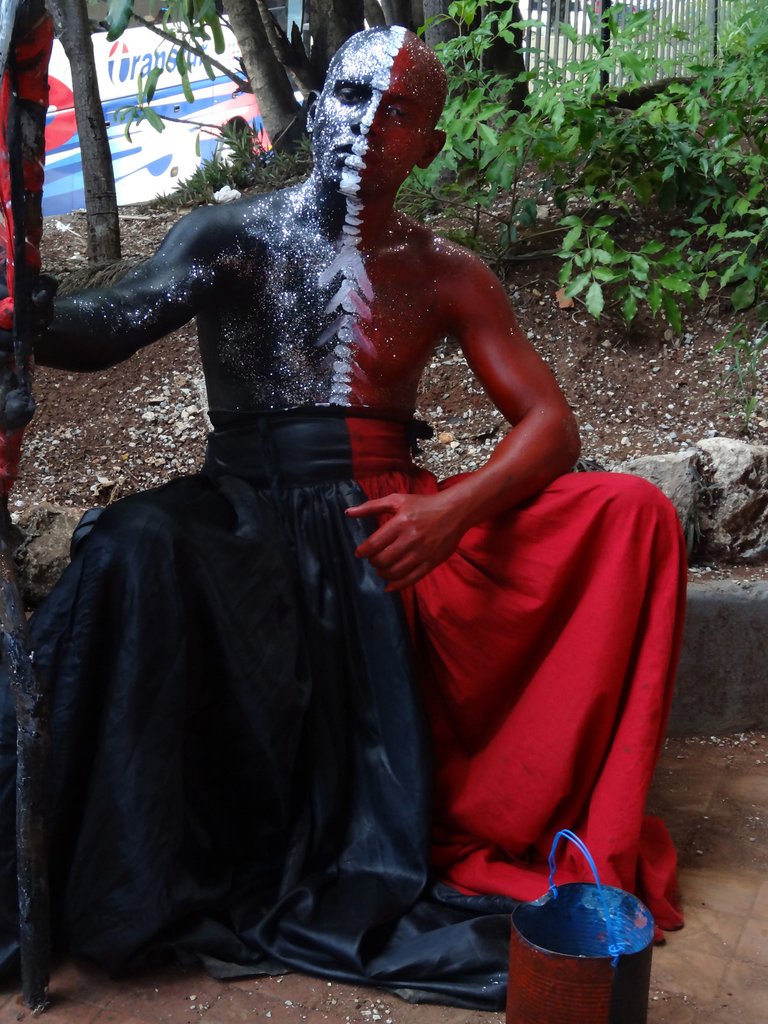
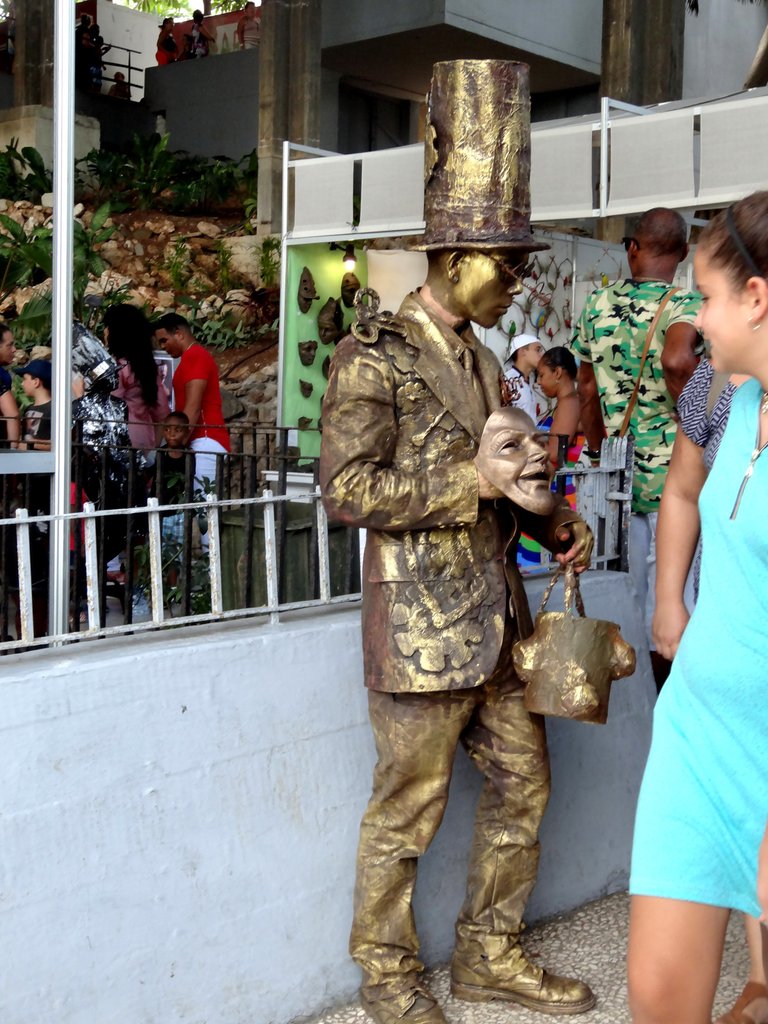
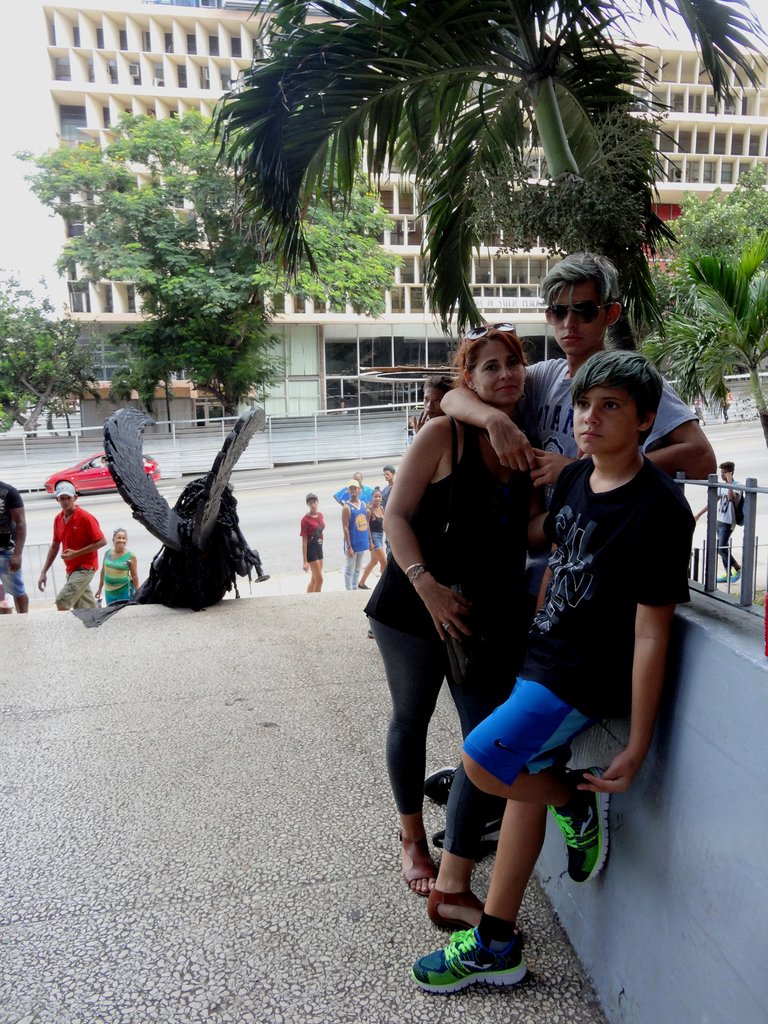
[Favio sorprendido con una estatua, que ni miró a la cámara /Favio surprised with a statue, who didn't even look at the camera]
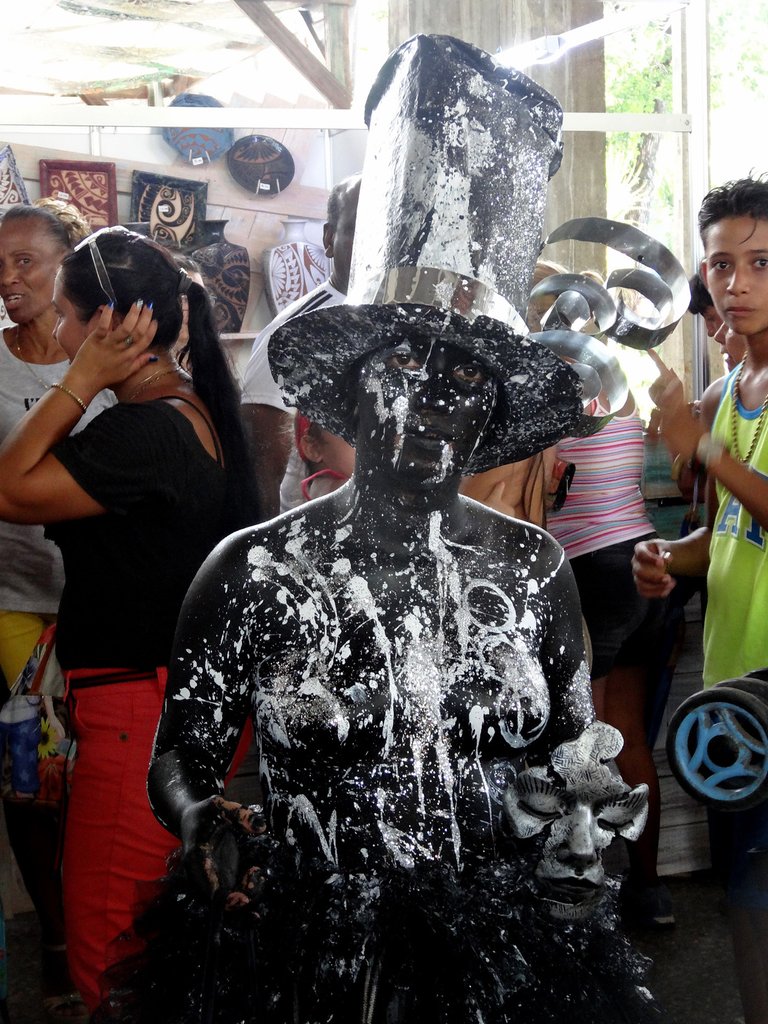
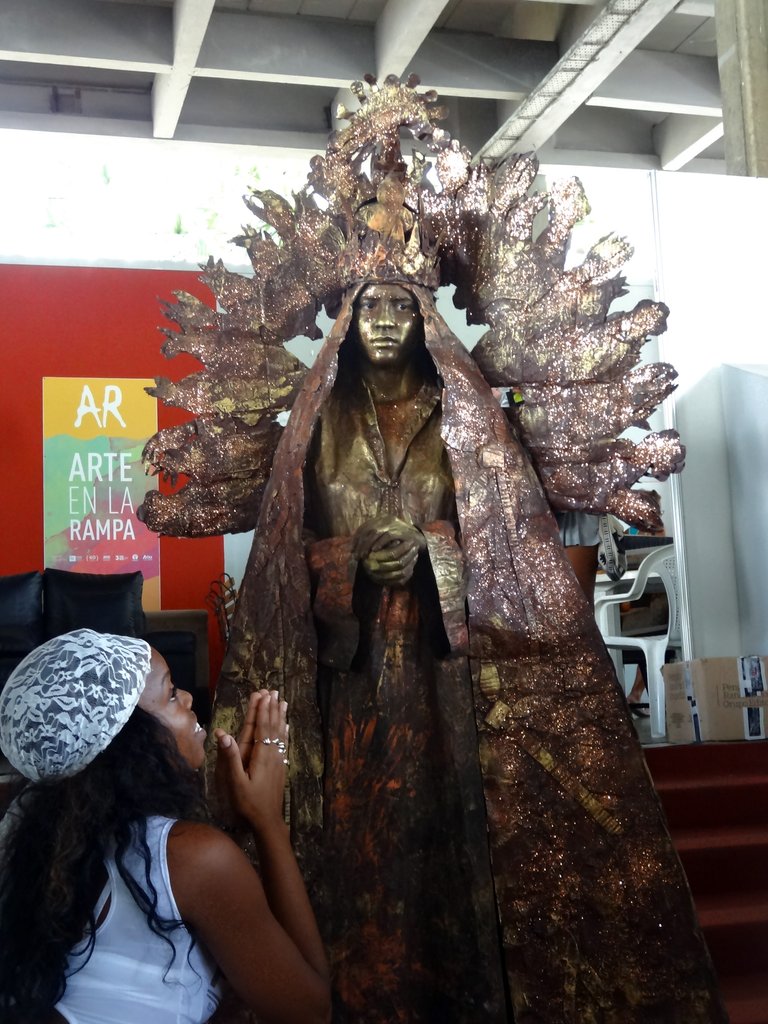
Estos protagonistas analizan el lugar más idóneo para su ubicación. Buscan zonas donde el paso de personas y el flujo de turistas es más concurrido. Algo que pueden apreciar en mis fotos, donde los encontramos situados en el paso principal de la entrada y salida al recinto, en escaleras y en tramos que comunican a otras salas de exposición.
Ponen en el piso o sostienen en sus manos, una lata o un sombrero. De esa manera, los que desean, les premian su arte con dinero. A veces, se ven personas que hasta les invocan, en postura de rezos, para que les cumplan a nivel espiritual sus anhelados deseos.
Saben con su manera original de expresar su arte, el hacer Busking. Palabra anglosajona, que engloba a toda actividad o espectáculo en sitios públicos, con el objetivo de entretener y captar el interés de los presentes; recibiendo recompensas, tras bailar, actuar, cantar o tocar algún instrumento musical.
Hay personas que pasan frente a ellos, y no logran percibir que se trata de un individuo real; marcando sus caras de sorpresa, cuando el busker les regala un sutil y pequeño gesto.
Gozan de lograr ese contraste dual en las multitudes: de parecer estatuas sin alma, por otra parte, de mostrar que no lo son. Disfrutando despertar la curiosidad ajena, al iniciar un pequeño movimiento e interactuar con las emociones del instante.
Recuerdo, que una vez le pregunté a uno de ellos, sobre los productos que usan para su maquillaje. —Refirió que hay pinturas que pueden ser tóxicas por sus componentes, por eso, buscan las más orgánicas para su piel y su ropa.
Respuesta veraz, ya que las pinturas sintéticas, tienen elementos dañinos que con el tiempo se absorben por vía inhalatoria, y más, por vía dérmica si el contacto es directo, pudiendo causar intoxicaciones agudas y enfermedades con el tiempo.
Usan polvos de piedra, cal, barro, carbón, y pigmentos para colorear en blanco, plateado, dorados y bronceados. Logrando de esa forma, la mejor apariencia al personaje que eligieron, junto a su vestuario que más lo caracterice.
Después, suman otros objetos, ej., gafas, armas cortantes y de fuego, libros, sombreros, flores, instrumentos musicales, y todo aquello que acreciente el realismo de su personaje. La parte emotiva y de interpretación, lo hace el resultado final que reflejan, en su accionar ante todos.
These protagonists analyze the most suitable place for their location. They look for areas where the passage of people and the flow of tourists is more crowded. Something that you can see in my photos, where we find them located in the main entrance and exit to the enclosure, on stairs and in sections that communicate to other exhibition halls.
They put on the floor or hold in their hands, a can or a hat. In this way, those who wish, reward them for their art with money. Sometimes, there are people who even invoke them, in the posture of prayers, so that their wishes are fulfilled on a spiritual level.
They know with their original way of expressing their art, the Busking. English-speaking word, which encompasses any activity or show in public places, in order to entertain and capture the interest of those present; receiving rewards, after dancing, acting, singing or playing a musical instrument.
There are people who pass in front of them, and do not manage to perceive that it is a real individual; marking their faces of surprise, when the busker gives them a subtle and small gesture.
They enjoy achieving that dual contrast in the crowds: to look like soulless statues, on the other hand, to show that they are not. Enjoying awakening the curiosity of others, initiating a small movement and interacting with the emotions of the moment.
I remember once I asked one of them about the products they use for their make-up. -He said that there are paints that can be toxic because of their components, that's why they look for the most organic ones for their skin and clothes.
Truthful answer, since synthetic paints have harmful elements that over time are absorbed through inhalation, and more, through the skin if the contact is direct, which can cause acute intoxications and diseases over time.
They use stone powders, lime, mud, charcoal, and pigments to color in white, silver, gold and tan. In this way, they achieve the best appearance for the character they have chosen, together with the costume that best characterizes him/her.
Then, they add other objects, e.g., glasses, sharp weapons and firearms, books, hats, flowers, musical instruments, and anything else that enhances the realism of their character. The emotional and interpretative part is done by the final result that they reflect in their actions in front of everyone.
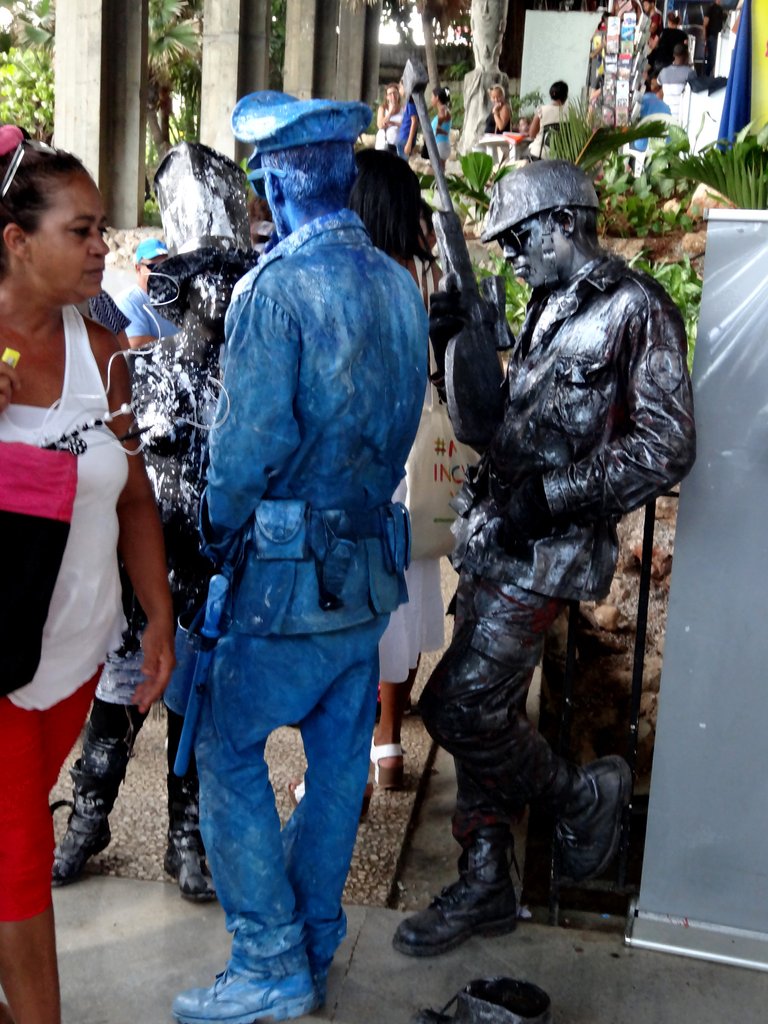
Este tipo de arte se empezó a ver en nuestro país hace 23 años, en algunas obras de teatro; después recibió el apoyo de la Oficina del Historiador de La Habana, extendiéndose por esa zona de la Habana Vieja, donde frecuentan muchos cubanos y extranjeros que disfrutan de nuestra isla.
Hoy vemos a estos creadores, animando y despertando los sentidos de nuestros hijos, tanto en hospitales, escuelas, ferias, conventos, parques, y hasta en paseos marítimos, donde se fusionan con un entorno que abraza la buena música, una gastronomía con sabor, los cócteles típicos, y ese ambiente de aire puro, ungido a la fragancia marina que tanto fertiliza las emociones.
Como todo trabajo artístico, para lograr su mejor resultado, necesitan entrenamiento, concentración, enfoque, y requieren de un estudio previo del personaje a interpretar, de las mejores locaciones que lo representen, y los objetos que deben portar. No es fácil permanecer inmóvil por tanto tiempo, aun sin pestañear ni mostrar señales evidentes de que respiran.
En esa magia que atesora a nuestra ciudad, con sus edificaciones que evocan las estructuras más variopintas; en ese andar de autos antiguos, besando con sus ruedas nuestras calles. A todos esos detalles, que lo hacen parecer un país detenido en el tiempo, según la opinión de algunos turistas foráneos; se suman estas estatuas vivientes, que con su apariencia y su arte, logran ventilar las emociones, coloreando de alegría y de vida a nuestra identidad nacional.
This type of art began to be seen in our country 23 years ago, in some plays; later it received the support of the Havana Historian's Office, spreading to that area of Habana Vieja, where many Cubans and foreigners who enjoy our island frequent.
Today we see these creators, animating and awakening the senses of our children, both in hospitals, schools, fairs, convents, parks, and even in promenades, where they merge with an environment that embraces good music, a gastronomy with flavor, typical cocktails, and that atmosphere of pure air, anointed with the marine fragrance that fertilizes the emotions.
Like all artistic work, to achieve the best results, they need training, concentration, focus, and require a previous study of the character to be interpreted, the best locations to represent it, and the objects to be carried. It is not easy to remain motionless for so long, even without blinking or showing obvious signs of breathing.
In that magic that treasures our city, with its buildings that evoke the most varied structures; in that walk of antique cars, kissing our streets with their wheels. To all these details, which make it look like a country stopped in time, according to the opinion of some foreign tourists, are added these living statues, which with their appearance and their art, manage to ventilate the emotions, coloring with joy and life to our national identity.
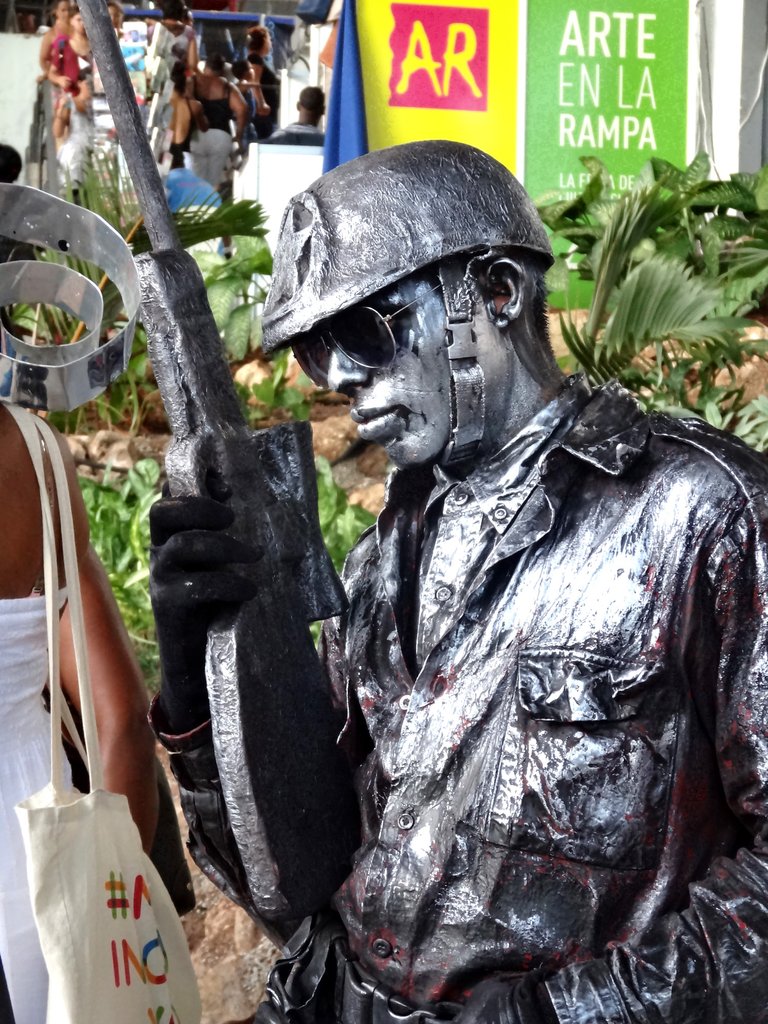
[El militar bajó su fusil a 90 grados de su cintura, cuando la sexy joven le besó sus labios/The military man lowered his rifle to 90 degrees from his waist, as the sexy young woman kissed his lips]
Fotos y Texto por/Photos and Text by Andrés Brunet
Referencias históricas de apoyo:
EcuRed y Wikipedia
Used camera: Sony DSC-HX20V
Gracias por leer/Thank you for reading
Bienvenidos sus comentarios/Welcome your comments
¡Saludos infinitos!/Infinite greetings!
He tenido el placer de ver alguna que otra en una visita que hice a Cienfuegos y tengo que admitir que el realismo del maquillaje es increíble!!!
Hola. Tal como refieres, son maestros maquillando su personaje, y más logrando su apariencia estática. Realmente, su arte es bien logrado. Saludos